The global seafood farming chillers market is valued at USD 6,625.1 million in 2025 and is slated to reach USD 12,436.2 million by 2035, recording an absolute increase of USD 5,811.1 million over the forecast period. This translates into a total growth of 87.7%, with the market forecast to expand at a compound annual growth rate (CAGR) of 6.5% between 2025 and 2035. The overall market size is expected to grow by nearly 1.88X during the same period, supported by increasing demand for temperature-controlled aquaculture systems, growing adoption of advanced cooling technologies in commercial fish farming operations, and rising preference for efficient thermal management solutions across marine and freshwater seafood production facilities.
Between 2025 and 2030, the seafood farming chillers market is projected to expand from USD 6,625.1 million to USD 8,522.9 million, resulting in a value increase of USD 1,897.8 million, which represents 32.7% of the total forecast growth for the decade. This phase of development will be shaped by increasing adoption of precision temperature control technologies, rising demand for energy-efficient cooling systems, and growing emphasis on automated thermal management solutions with enhanced reliability characteristics. Aquaculture operators are expanding their chiller system capabilities to address the growing demand for optimal water temperature maintenance, disease prevention, and specialty seafood production requirements.
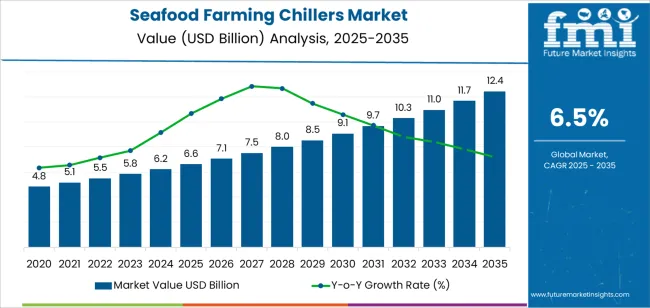
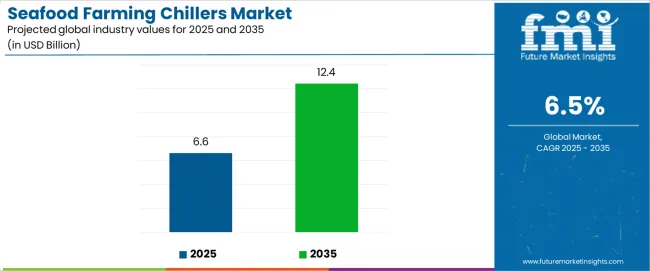
Seafood Farming Chillers Market Key Takeaways
| Metric | Value |
|---|---|
| Estimated Value in (2025E) | USD 6,625.1 million |
| Forecast Value in (2035F) | USD 12,436.2 million |
| Forecast CAGR (2025 to 2035) | 6.5% |
From 2030 to 2035, the market is forecast to grow from USD 8,522.9 million to USD 12,436.2 million, adding another USD 3,913.3 million, which constitutes 67.3% of the overall ten-year expansion. This period is expected to be characterized by the expansion of IoT-enabled cooling systems, the integration of AI-powered temperature monitoring platforms, and the development of multi-zone chiller configurations with enhanced energy efficiency capabilities. The growing adoption of smart aquaculture practices will drive demand for seafood farming chillers with superior control systems and compatibility with farm management software across commercial operations.
Between 2020 and 2025, the seafood farming chillers market experienced robust growth, driven by increasing demand for modern aquaculture practices and growing recognition of temperature control technology as essential equipment for efficient seafood production across large-scale fish farming, shrimp cultivation, and marine species management applications. The market developed as aquaculture operators recognized the potential for chillers to optimize water conditions while maintaining production efficiency and enabling cost-effective thermal management protocols. Technological advancement in refrigeration systems and precision temperature control mechanisms began emphasizing the critical importance of maintaining optimal water temperatures and thermal stability in diverse aquaculture environments.
Market expansion is being supported by the increasing global demand for controlled-environment aquaculture solutions and the corresponding need for automated systems that can provide superior temperature regulation and thermal efficiency while enabling reduced energy consumption and environmental impact across various seafood farming and marine cultivation applications. Modern aquaculture operations and seafood production specialists are increasingly focused on implementing chiller technologies that can deliver consistent thermal control, prevent temperature fluctuations, and provide reliable cooling performance throughout complex production cycles and diverse aquatic conditions. Seafood farming chillers' proven ability to deliver exceptional temperature precision against environmental variations, enable energy-efficient operations, and support cost-effective cooling protocols make them essential equipment for contemporary aquaculture and commercial seafood production operations.
The growing emphasis on aquaculture efficiency and production optimization is driving demand for seafood farming chillers that can support large-scale farming requirements, improve yield outcomes, and enable automated temperature management systems. Operators' preference for technology that combines effective thermal control with operational reliability and energy efficiency is creating opportunities for innovative chiller implementations. The rising influence of smart aquaculture and precision farming practices is also contributing to increased demand for seafood farming chillers that can provide real-time temperature monitoring, predictive maintenance capabilities, and consistent performance across extended operational periods.
The seafood farming chillers market is poised for rapid growth and transformation. As industries across aquaculture, marine farming, freshwater cultivation, and seafood processing seek solutions that deliver exceptional temperature control, operational efficiency, and energy conservation, seafood farming chillers are gaining prominence not just as specialized equipment but as strategic enablers of modern aquaculture practices and production optimization.
Rising precision aquaculture adoption in Asia-Pacific and expanding smart farming initiatives globally amplify demand, while manufacturers are leveraging innovations in refrigeration systems, IoT connectivity, and integrated monitoring technologies.
Pathways like high-capacity cooling platforms, AI-powered temperature control systems, and specialized aquatic environment solutions promise strong margin uplift, especially in large-scale commercial segments. Geographic expansion and technology integration will capture volume, particularly where local aquaculture practices and thermal management adoption are critical. Regulatory support around aquaculture modernization, energy efficiency requirements, and production quality standards give structural support.
The market is segmented by chiller type, application, capacity range, end-use sector, and region. By chiller type, the market is divided into vertical type, horizontal type, box type, and others. By application, it covers seawater farming, freshwater farming, industrial farming, and others. By capacity range, the market includes high capacity (≥500 tons), medium capacity (100-500 tons), and low capacity (<100 tons). By end-use sector, it is categorized into commercial aquaculture, seafood processing facilities, research institutions, and government agencies. Regionally, the market is divided into North America, Europe, East Asia, South Asia & Pacific, Latin America, and the Middle East & Africa.
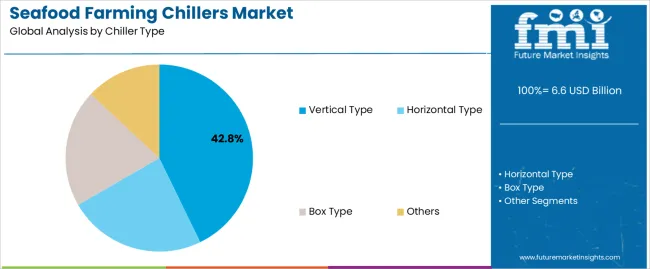
The vertical type segment is projected to account for 42.8% of the seafood farming chillers market in 2025, reaffirming its position as the leading configuration category. Large-scale aquaculture operations and commercial seafood producers increasingly utilize vertical type chillers for their superior space efficiency when operating in confined facility areas, excellent cooling performance characteristics, and cost-effectiveness in applications ranging from temperature control to large-area thermal management. Vertical type chiller technology's advanced refrigeration system capabilities and compact footprint directly address the industrial requirements for efficient cooling in space-constrained aquaculture environments.
This configuration segment forms the foundation of modern commercial aquaculture operations, as it represents the chiller type with the greatest space optimization and established market demand across multiple application categories and farming sectors. Manufacturer investments in enhanced compressor technologies and automated control compatibility continue to strengthen adoption among aquaculture contractors and large seafood production enterprises. With companies prioritizing operational efficiency and space utilization, vertical type chillers align with both performance requirements and facility optimization objectives, making them the central component of comprehensive aquaculture cooling strategies.
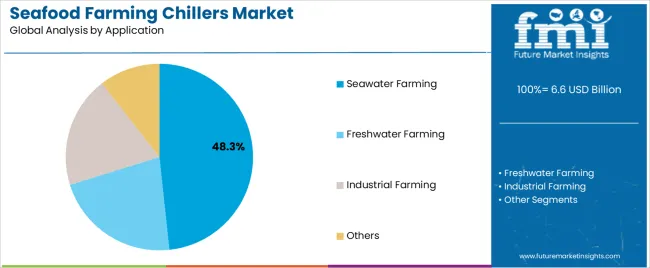
Seawater farming applications are projected to represent 48.3% of seafood farming chillers demand in 2025, underscoring their critical role as the primary marine consumers of precision cooling technology for saltwater species cultivation, marine aquaculture, and seawater-based production applications. Seawater farming operators prefer chillers for their exceptional corrosion resistance capabilities, saltwater-compatible operational characteristics, and ability to maintain optimal temperatures while ensuring effective thermal control throughout diverse marine production programs. Positioned as essential equipment for modern marine aquaculture operations, seafood farming chillers offer both efficiency advantages and environmental control benefits.
The segment is supported by continuous innovation in corrosion-resistant technologies and the growing availability of specialized cooling systems that enable variable temperature control with enhanced durability and reliable marine environment performance capabilities. Additionally, seawater farming operators are investing in integrated monitoring systems to support large-scale chiller utilization and operational planning. As marine aquaculture demand becomes more prevalent and seawater farming efficiency requirements increase, seawater farming applications will continue to dominate the end-use market while supporting advanced aquaculture automation utilization and thermal control strategies.
The seafood farming chillers market is advancing rapidly due to increasing demand for precision aquaculture technologies and growing adoption of automated temperature control solutions that provide superior thermal regulation and operational efficiency while enabling reduced energy consumption across diverse seafood farming and aquaculture management applications. However, the market faces challenges, including high initial equipment costs, maintenance complexity requirements, and the need for specialized technical support and installation programs. Innovation in smart control capabilities and IoT-enabled monitoring systems continues to influence product development and market expansion patterns.
Expansion of Smart Control and Automation Technologies
The growing adoption of IoT-enabled monitoring systems, AI-powered temperature optimization algorithms, and machine learning-based cooling control is enabling manufacturers to produce advanced seafood farming chillers with superior decision-making capabilities, enhanced operational precision, and automated thermal management functionalities. Advanced smart control systems provide improved temperature accuracy while allowing more efficient energy utilization and consistent performance across various aquatic species and environmental conditions. Manufacturers are increasingly recognizing the competitive advantages of smart chiller capabilities for operational differentiation and premium market positioning.
Integration of Energy Efficiency and Environmental Technologies
Modern seafood farming chiller producers are incorporating variable speed drives, heat recovery systems, and advanced refrigeration technologies to enhance energy efficiency, enable predictive maintenance capabilities, and deliver environmentally conscious solutions to aquaculture customers. These technologies improve operational efficiency while enabling new cooling capabilities, including real-time energy monitoring, consumption optimization tracking, and reduced operational overhead. Advanced energy integration also allows manufacturers to support comprehensive facility management systems and aquaculture modernization beyond traditional manual cooling approaches.
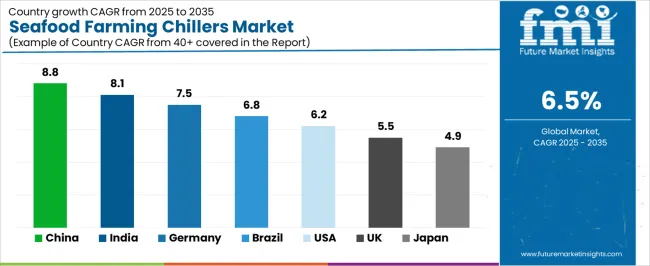
| Country | CAGR (2025 to 2035) |
|---|---|
| China | 8.8% |
| India | 8.1% |
| Germany | 7.5% |
| Brazil | 6.8% |
| USA | 6.2% |
| UK | 5.5% |
| Japan | 4.9% |
The seafood farming chillers market is experiencing strong growth globally, with China leading at an 8.8% CAGR through 2035, driven by the expanding aquaculture modernization programs, growing precision farming adoption, and significant investment in cooling technology development. India follows at 8.1%, supported by government initiatives promoting aquaculture technology, increasing seafood production demand, and growing temperature control requirements. Germany shows growth at 7.5%, emphasizing precision aquaculture innovation and advanced cooling technology development. Brazil records 6.8%, focusing on large-scale seafood farming expansion and commercial aquaculture modernization. The USA demonstrates 6.2% growth, prioritizing aquaculture efficiency standards and farming automation excellence. The UK exhibits 5.5% growth, emphasizing aquaculture technology adoption and precision farming development. Japan shows 4.9% growth, supported by high-tech aquaculture initiatives and precision farming concentration.
The report covers an in-depth analysis of 40+ countries; seven top-performing countries are highlighted below.
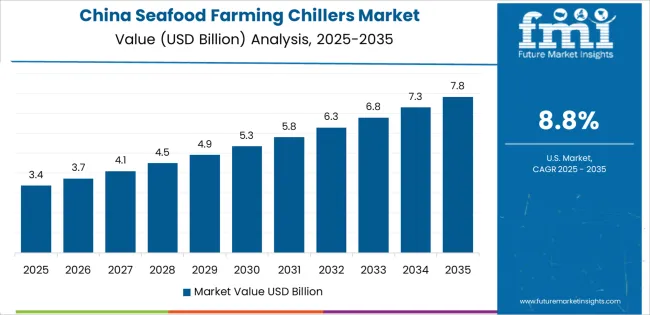
Revenue from seafood farming chillers in China is projected to exhibit exceptional growth with a CAGR of 8.8% through 2035, driven by expanding aquaculture modernization programs and rapidly growing precision farming adoption supported by government initiatives promoting aquaculture technology development. The country's strong position in seafood production and increasing investment in smart aquaculture infrastructure are creating substantial demand for advanced chiller solutions. Major seafood producers and aquaculture enterprises are establishing comprehensive cooling system capabilities to serve both domestic seafood production demand and aquaculture efficiency markets.
Revenue from seafood farming chillers in India is expanding at a CAGR of 8.1%, supported by the country's massive aquaculture sector, expanding government support for seafood farming modernization, and increasing adoption of precision temperature control solutions. The country's initiatives promoting aquaculture technology and growing farmer awareness are driving requirements for advanced cooling capabilities. International suppliers and domestic manufacturers are establishing extensive production and service capabilities to address the growing demand for chiller products.
Revenue from seafood farming chillers in Germany is expanding at a CAGR of 7.5%, supported by the country's advanced precision aquaculture capabilities, strong emphasis on cooling technology innovation, and robust demand for high-performance aquaculture automation in temperature control and facility management applications. The nation's mature seafood sector and efficiency-focused operations are driving sophisticated chiller systems throughout the aquaculture industry. Leading manufacturers and technology providers are investing extensively in smart control systems and precision cooling technologies to serve both domestic and international markets.
Revenue from seafood farming chillers in Brazil is growing at a CAGR of 6.8%, driven by the country's expanding aquaculture sector, growing commercial seafood operations, and increasing investment in aquaculture technology development. Brazil's extensive coastline and commitment to seafood farming modernization are supporting demand for efficient chiller solutions across multiple seafood production segments. Manufacturers are establishing comprehensive service capabilities to serve the growing domestic market and seafood export opportunities.
Revenue from seafood farming chillers in the USA is expanding at a CAGR of 6.2%, supported by the country's advanced aquaculture technology sector, strategic focus on farming efficiency, and established precision temperature control capabilities. The USA's aquaculture innovation leadership and technology integration are driving demand for chillers in commercial seafood production, specialty aquaculture, and research applications. Manufacturers are investing in comprehensive technology development to serve both domestic aquaculture markets and international specialty applications.
Revenue from seafood farming chillers in the UK is growing at a CAGR of 5.5%, driven by the country's focus on aquaculture technology advancement, emphasis on farming efficiency, and strong position in precision aquaculture development. The UK's established aquaculture innovation capabilities and commitment to seafood farming modernization are supporting investment in advanced cooling technologies throughout major production regions. Industry leaders are establishing comprehensive technology integration systems to serve domestic aquaculture operations and specialty seafood applications.
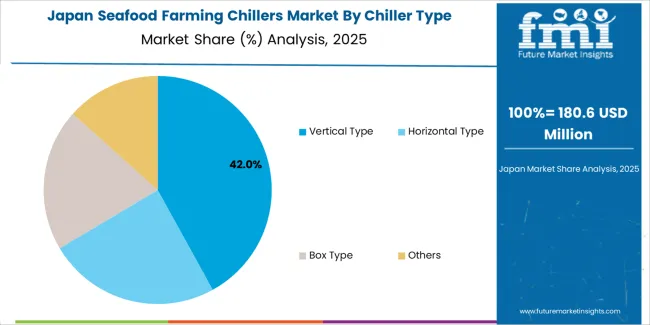
Revenue from seafood farming chillers in Japan is expanding at a CAGR of 4.9%, supported by the country's high-tech aquaculture initiatives, growing precision farming sector, and strategic emphasis on aquaculture automation development. Japan's advanced technology capabilities and integrated aquaculture systems are driving demand for advanced chillers in specialty seafood production, precision aquaculture, and high-value marine applications. Leading manufacturers are investing in specialized capabilities to serve the stringent requirements of high-tech aquaculture and precision seafood farming industries.
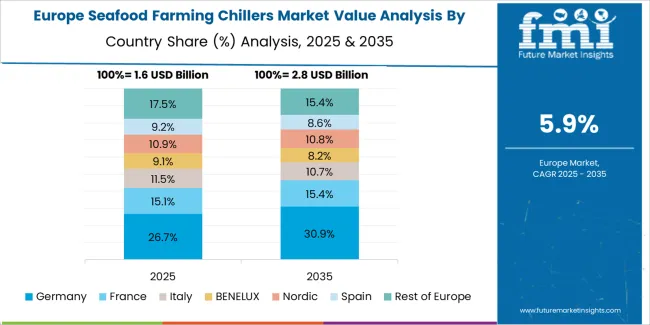
The seafood farming chillers market in Europe is projected to grow from USD 1,125.7 million in 2025 to USD 2,113.4 million by 2035, registering a CAGR of 6.5% over the forecast period. Germany is expected to maintain its leadership position with a 33.8% market share in 2025, declining slightly to 33.4% by 2035, supported by its strong precision aquaculture sector, advanced cooling technology capabilities, and comprehensive aquaculture automation industry serving diverse chiller applications across Europe.
Norway follows with a 21.2% share in 2025, projected to reach 21.8% by 2035, driven by robust demand for chillers in salmon farming, aquaculture modernization programs, and precision temperature control applications, combined with established aquaculture technology infrastructure and marine species expertise. The United Kingdom holds a 16.9% share in 2025, expected to reach 17.3% by 2035, supported by strong aquaculture technology sector and growing precision farming activities. France commands a 12.4% share in 2025, projected to reach 12.7% by 2035, while Spain accounts for 8.7% in 2025, expected to reach 9.1% by 2035. The Netherlands maintains a 4.2% share in 2025, growing to 4.4% by 2035. The Rest of Europe region, including Nordic countries, Eastern Europe, Belgium, Poland, and other nations, is anticipated to maintain momentum, with its collective share moving from 2.8% to 1.3% by 2035, attributed to increasing aquaculture modernization in Eastern Europe and growing precision farming penetration in Nordic countries implementing advanced aquaculture technology programs.
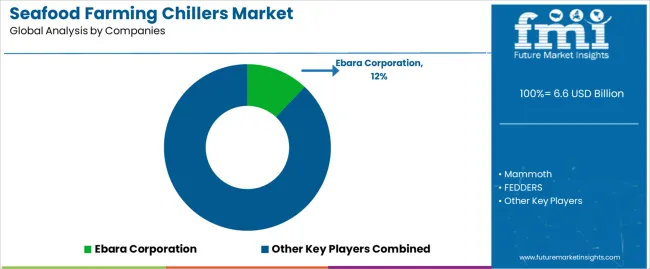
The seafood farming chillers market is characterized by competition among established cooling system manufacturers, specialized aquaculture technology producers, and integrated precision temperature control solutions providers. Companies are investing in smart control technology research, capacity optimization, precision cooling system development, and comprehensive product portfolios to deliver consistent, high-performance, and application-specific chiller solutions. Innovation in IoT-enabled systems, energy efficiency integration, and operational reliability enhancement is central to strengthening market position and competitive advantage.
Ebara Corporation leads the market with a strong market share, offering comprehensive chiller solutions including advanced cooling control systems with a focus on aquaculture and commercial applications. Mammoth provides specialized cooling capabilities with an emphasis on energy-efficient systems and automated temperature operations. FEDDERS delivers innovative cooling products with a focus on high-capacity platforms and commercial aquaculture services. Qingdao KC Blue New Energy specializes in aquaculture automation and chiller technologies for large-scale seafood farming applications. Shandong St.claier focuses on precision cooling equipment and integrated aquaculture solutions. Guangdong AQUA offers specialized cooling platforms with emphasis on commercial aquaculture and marine applications.
Key Players in the Seafood Farming Chillers Market
| Items | Values |
|---|---|
| Quantitative Units (2025) | USD 6,625.1 million |
| Chiller Type | Vertical Type, Horizontal Type, Box Type, Others |
| Application | Seawater Farming, Freshwater Farming, Industrial Farming, Others |
| Capacity Range | High Capacity (≥500 tons), Medium Capacity (100-500 tons), Low Capacity (<100 tons) |
| End-Use Sector | Commercial Aquaculture, Seafood Processing Facilities, Research Institutions, Government Agencies |
| Regions Covered | North America, Europe, East Asia, South Asia & Pacific, Latin America, Middle East & Africa |
| Countries Covered | China, India, Germany, Brazil, United States, United Kingdom, Japan and 40+ countries |
| Key Companies Profiled | Ebara Corporation, Mammoth, FEDDERS, Qingdao KC Blue New Energy, and Shandong St.claier |
| Additional Attributes | Dollar sales by chiller type and application category, regional demand trends, competitive landscape, technological advancements in smart control systems, energy efficiency development, IoT integration innovation, and aquaculture service integration |
The global seafood farming chillers market is estimated to be valued at USD 6.6 billion in 2025.
The market size for the seafood farming chillers market is projected to reach USD 12.4 billion by 2035.
The seafood farming chillers market is expected to grow at a 6.5% CAGR between 2025 and 2035.
The key product types in seafood farming chillers market are vertical type, horizontal type, box type and others.
In terms of application, seawater farming segment to command 48.3% share in the seafood farming chillers market in 2025.






Full Research Suite comprises of:
Market outlook & trends analysis
Interviews & case studies
Strategic recommendations
Vendor profiles & capabilities analysis
5-year forecasts
8 regions and 60+ country-level data splits
Market segment data splits
12 months of continuous data updates
DELIVERED AS:
PDF EXCEL ONLINE
Seafood Packaging Market Size and Share Forecast Outlook 2025 to 2035
Seafood Takeout Market Size and Share Forecast Outlook 2025 to 2035
Seafood Packaging Market Size, Share & Forecast 2025 to 2035
Seafood Flavors Market Growth - Innovations & Industry Demand 2025 to 2035
Evaluating Seafood Packaging Market Share & Provider Insights
Seafood Market Analysis - Size, Share, and Forecast 2024 to 2034
Live Seafood Market Size and Share Forecast Outlook 2025 to 2035
Canned Seafood Market Size, Growth, and Forecast for 2025 to 2035
Frozen Seafood Market Analysis by Nature, Form, End Use, Distribution Channel and Other Products Type Through 2035
Functional Seafood Market Size and Share Forecast Outlook 2025 to 2035
Ready To Eat Seafood Snacks Market Size and Share Forecast Outlook 2025 to 2035
Meat, Poultry, and Seafood Packaging Market Size and Share Forecast Outlook 2025 to 2035
Market Share Breakdown of Meat, Poultry, and Seafood Packaging Manufacturers
Farming Sack and Tote Market Report – Trends, Size & Forecast 2024 to 2034
Indoor Farming Market Analysis - Size, Share, and Forecast 2025 to 2035
A Detailed Global Analysis of Brand Share for the Indoor Farming Market
Poultry Farming Equipment Market Size and Share Forecast Outlook 2025 to 2035
Vertical Farming Market Size and Share Forecast Outlook 2025 to 2035
Horse Drawn Farming Equipment Market Size and Share Forecast Outlook 2025 to 2035
AI for Hydroponic Farming Market Size and Share Forecast Outlook 2025 to 2035

Thank you!
You will receive an email from our Business Development Manager. Please be sure to check your SPAM/JUNK folder too.
Chat With
MaRIA